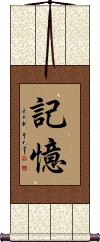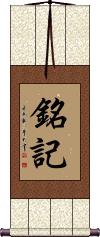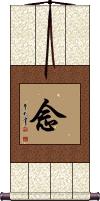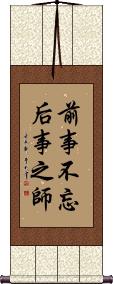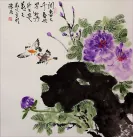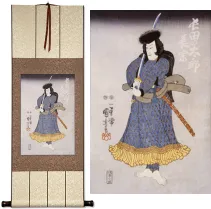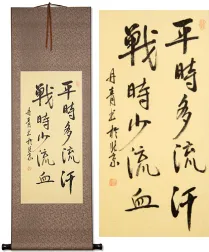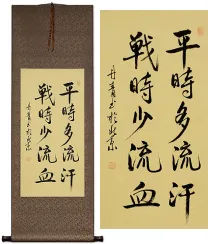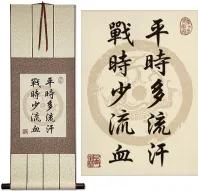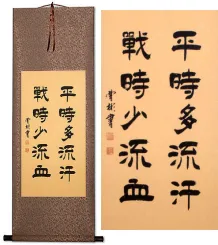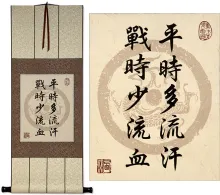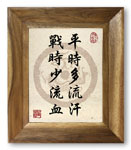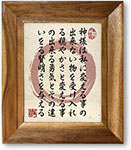Many custom options...
And formats...

In Memory Of in Chinese / Japanese...
Buy an In Memory Of calligraphy wall scroll here!
Personalize your custom “In Memory Of” project by clicking the button next to your favorite “In Memory Of” title below...
1. 7. Right Mindfulness / Right Memory / Perfect Mindfulness
2. Remember
3. Monkey
4. All Tenets of the Noble Eightfold Path
5. Remember
6. Mindfulness
7. Right Mindfulness / Right Memory / Perfect Mindfulness
Samyak Smriti / Samyak Smrti / Samma Sati
正念 is one of the Noble Eightfold Paths of Buddhism. Right Mindfulness, along with Right Effort and Right Concentration, constitute the path to Concentration or Perfect Thought.
Right Mindfulness is about remaining focused on one's body, feelings, mind, and mental qualities. It's also about being ardent, aware, and mindful, and supposes that you've already put aside worldly desire and aversion.
Monk Bhikkhu Bodhi described this as “The mind is deliberately kept at the level of bare attention, a detached observation of what is happening within us and around us in the present moment.” When practicing right mindfulness, the mind is trained to remain in the present, open, quiet, and alert, contemplating the present event.
Another definition: Ongoing mindfulness of body, feelings, thinking, and objects of thought.
This term is exclusively used by devout Buddhists. It is not a common term, and is remains an unknown concept to most Japanese and Chinese people.
See Also: Buddhism | Enlightenment | Noble Eightfold Path
Remember
記憶 is a Japanese Kanji, old Korean Hanja, and Chinese word that means “to remember.”
This can also be translated as memory, to recall, recollection, or remembrance.
Monkey
Year of the Monkey / Zodiac Sign
猴 is the monkey character in Chinese.
猴 means ape in Japanese due to an error made long ago as Japan absorbed Chinese characters.
If you were born in the year of the monkey, you . . .
Are smart, brave, active, and competitive.
Like new things.
Have a good memory.
Are quick to respond
Have an easy time winning people's trust.
Are, however, not very patient.
See also our Chinese Zodiac page.
Note: This character does have the meaning of monkey in Korean Hanja but is not used very often.
All Tenets of the Noble Eightfold Path
These are the eight tenets of the Buddhist Noble Eightfold Path written altogether.
Here's this list of tenets in English:
1. Right View / Right Understanding / Right Perspective / Perfect View
2. Right Resolve / Right Thought / Right Intention / Perfect Resolve
3. Right Speech / Right Talk / Perfect Speech
4. Right Action / Perfect Conduct
5. Right Living / Right Livelihood / Perfect Livelihood
6. Right Effort / Right Endeavor / Perfect Effort
7. Right Mindfulness / Right Memory / Perfect Mindfulness
8. Right Concentration / Perfect Concentration
Remember
銘記 means to keep in mind, to take note of, or simply to remember, in Chinese characters and Japanese Kanji.
The first character means to engrave, inscribe, or carve an inscription.
The second character means to remember, note, mark, sign, record, history, chronicle, or annals.
When used in the context of a person, this means to engrave on the heart or to inscribe a memory in one's mind. In short, it's the idea of deeply remembering something, some event, or someone forever.
Mindfulness
念 is the simplest way to write “mindfulness” in Chinese, Japanese Kanji, and old Korean Hanja.
念 can be defined these ways: To read; to study (a degree course); to read aloud; to miss somebody (keeping them in your mind); idea; remembrance; sense; thought; feeling; desire; concern; attention; recollection; memory; to think on/about; reflect; repeat, intone; a moment.
Obviously, the context in which the character is used determines which definition or meaning is perceived. As a single character, it's open and perhaps ambiguous. Thus, it can be read with any or all of these meanings.
念 is used in a Buddhist context (often written as 正念 or “right mindfulness”) with similar meanings of thought and contemplation.
In Japanese, this character is sometimes used as the name “Nen.”
See Also: Buddhism | Enlightenment
Past experience is the teacher for the future
Past events not forgotten serve as teachers for later events.
The most literal translation to English of this ancient 前事不忘后事之师 Chinese proverb is:
“Past events not forgotten serve as teachers for later events.”
However, it's been translated several ways:
Don't forget past events, they can guide you in the future.
Benefit from past experience.
Past experience, if not forgotten, is a guide for the future.
Past calamity is my teacher.
A good memory for the past is a teacher for the future.
The remembrance of the past is the teacher of the future.
If one remembers the lessons of the past; They will serve as a guide to avoid mistakes in the future.
The origin:
This proverb comes from the 5th century B.C., just before the Warring States Period in the territory now known as China.
The head of the State of Jin, Zhi Bo, seized power in a coup. He did this with help from the armies of the State of Han and Wei. Instead of being grateful for the help from Han and Wei, he treacherously took the land of Han and Wei. Never satisfied, Zhi Bo employed the armies of Han and Wei to attack and seize the State of Zhao.
The king of Zhao took advice from his minister Zhang Mengtan and secretly contacted the Han and Wei armies to reverse their plans and attack the army of Zhi Bo instead. The plan was successful, and the State of Zhao was not only saved but was set to become a powerful kingdom in the region.
Zhang Mengtan immediately submitted his resignation to a confused king of Zhao. When asked why, Zhang Mengtan said, “I've done my duty to save my kingdom, but looking back at past experience, I know sovereign kings are never satisfied with the power or land at hand. They will join others and fight for more power and more land. I must learn from past experiences, as those experiences are the teachers of future events.”
The king could not dispute the logic in that statement and accepted Zhang Mengtan's resignation.
For generations, the State of Zhao continued to fight for power and land until finally defeated and decimated by the State of Qin (which led to the birth of the Qin Dynasty in 221 B.C.).
This in-stock artwork might be what you are looking for, and ships right away...
Gallery Price: $286.00
Your Price: $158.88
Gallery Price: $108.00
Your Price: $59.88
Gallery Price: $120.00
Your Price: $61.88
Gallery Price: $120.00
Your Price: $61.88
Gallery Price: $220.00
Your Price: $112.88
Gallery Price: $90.00
Your Price: $49.88
Gallery Price: $60.00
Your Price: $36.88
Gallery Price: $220.00
Your Price: $99.88
Gallery Price: $106.00
Your Price: $58.88
Starting at: $19.88
Gallery Price: $61.00
Your Price: $33.88
Not the results for in memory of that you were looking for?
Below are some entries from our dictionary that may match your in memory of search...
| Characters If shown, 2nd row is Simp. Chinese |
Pronunciation Romanization |
Simple Dictionary Definition |
哀慕 see styles |
aibo あいぼ |
cherish the memory of; yearn for |
守節 守节 see styles |
shǒu jié shou3 jie2 shou chieh |
faithful (to the memory of betrothed); constant (of widow who remains unmarried) |
念想 see styles |
niàn xiǎng nian4 xiang3 nien hsiang |
to miss (the presence of); to cherish the memory of; aspiration; desire; something one keeps thinking about; (coll.) keepsake; memento; (coll.) impression (of sb or something in one's mind) |
思慕 see styles |
sī mù si1 mu4 ssu mu shibo しぼ |
to cherish the memory of sb; to think of with respect (noun, transitive verb) yearning; longing for; deep affection longing for |
懷古 怀古 see styles |
huái gǔ huai2 gu3 huai ku |
to recall the past; to cherish the memory of past events; to reminisce; nostalgic |
懷念 怀念 see styles |
huái niàn huai2 nian4 huai nien |
to cherish the memory of; to think of; to reminisce |
紀念 纪念 see styles |
jì niàn ji4 nian4 chi nien kinen きねん |
to commemorate; to honor the memory of; memento; keepsake; souvenir (noun/participle) commemoration; celebration; honoring the memory of something; turning something into a memento; memory; (personal name) Kinen |
茶事 see styles |
chagoto; chaji; saji ちゃごと; ちゃじ; さじ |
(1) tea gathering (for the tea ceremony); (2) some matter concerning tea; (3) family tea gathering held in memory of deceased ancestors |
記念 记念 see styles |
jì niàn ji4 nian4 chi nien kinen きねん |
variant of 紀念|纪念[ji4 nian4] (noun/participle) commemoration; celebration; honoring the memory of something; turning something into a memento; memory remembrance |
追慕 see styles |
tsuibo ついぼ |
(noun, transitive verb) cherishing the memory of; yearning for |
武侯祠 see styles |
wǔ hóu cí wu3 hou2 ci2 wu hou tz`u wu hou tzu |
temple dedicated to the memory of Zhuge Liang 諸葛亮|诸葛亮[Zhu1 ge3 Liang4] (There is one in Chengdu, and many others in various parts of China.) |
記念館 see styles |
kinenkan きねんかん |
museum (esp. in memory of a person or event); memorial hall |
四無所畏 四无所畏 see styles |
sì wú suǒ wèi si4 wu2 suo3 wei4 ssu wu so wei shi mushoi |
(四無畏) The four kinds of fearlessness, or courage, of which there are two groups: Buddha-fearlessness arises from his omniscience; perfection of character; overcoming opposition; and ending of suffering. Bodhisattva-fearlessness arises from powers of memory; of moral diagnosis and application of the remedy; of ratiocination; and of solving doubts. v. 智度論 48 and 5. |
宿住隨念 宿住随念 see styles |
sù zhù suí niàn su4 zhu4 sui2 nian4 su chu sui nien shukujū zuinen |
memory of prior lifetimes |
川施餓鬼 川施饿鬼 see styles |
chuān shī è guǐ chuan1 shi1 e4 gui3 ch`uan shih o kuei chuan shih o kuei kawasegaki かわせがき |
Buddhist services in memory of those drowned in a river; offering to suffering spirits at the river Making offerings at the streams to the ghosts of the drowned. |
耳に残る see styles |
mimininokoru みみにのこる |
(exp,v5r) to remain in memory (of sounds and words); to linger in one's ears |
聞き覚え see styles |
kikioboe ききおぼえ |
(1) learning by ear; (2) memory of having heard something before |
追善興行 see styles |
tsuizenkougyou / tsuizenkogyo ついぜんこうぎょう |
memorial performance; performance in memory of someone |
聞きおぼえ see styles |
kikioboe ききおぼえ |
(1) learning by ear; (2) memory of having heard something before |
ひめゆりの塔 see styles |
himeyurinotou / himeyurinoto ひめゆりのとう |
(place-name) Himeyuri Monument (at Itoman to the memory of the "Himeyuri" (Star Lily) nurses, who died in Okinawa in the final stages of the Second World War) |
後家を立てる see styles |
gokeotateru ごけをたてる |
(exp,v1) to remain faithful to the memory of one's husband and never remarry |
身に覚えがある see styles |
minioboegaaru / minioboegaru みにおぼえがある |
(exp,v5r-i) to have the memory of having done something oneself |
身に覚えが有る see styles |
minioboegaaru / minioboegaru みにおぼえがある |
(exp,v5r-i) to have the memory of having done something oneself |
身に覚えのある see styles |
minioboenoaru みにおぼえのある |
(exp,adj-f) (See 身に覚えのない) having the memory of having done something oneself; familiar (to one); guilty (look, expression, etc.) |
身に覚えの有る see styles |
minioboenoaru みにおぼえのある |
(exp,adj-f) to have the memory of having done something oneself (subordinate phrase) |
Variations: |
kinen きねん |
(noun/participle) commemoration; celebration; honoring the memory of something; turning something into a memento; memory |
Variations: |
kikioboe ききおぼえ |
(1) learning by ear; (2) (See 聞き覚えがある) memory of having heard something before |
Variations: |
kiokuninai きおくにない |
(exp,adj-i) not in one's recollection; having no recollection (of); having no memory (of) |
Variations: |
kinen きねん |
(noun, transitive verb) (1) commemoration; celebration; remembrance; memory; honoring the memory of; (2) memento; souvenir; keepsake |
Variations: |
minioboegaaru / minioboegaru みにおぼえがある |
(exp,v5r-i) (See 身に覚えのある) to have the memory of having done something oneself |
Click here for more in memory of results from our dictionary
The following table may be helpful for those studying Chinese or Japanese...
| Title | Characters | Romaji (Romanized Japanese) | Various forms of Romanized Chinese | |
| 7. Right Mindfulness Right Memory Perfect Mindfulness | 正念 | sei nen / seinen | zhèng niàn zheng4 nian4 zheng nian zhengnian | cheng nien chengnien |
| Remember | 記憶 | kioku | jì yì / ji4 yi4 / ji yi / jiyi | chi i / chii |
| Monkey | 猴 | hóu / hou2 / hou | ||
| All Tenets of the Noble Eightfold Path | 正見正思唯正語正業正命正精進正念正定 正见正思唯正语正业正命正精进正念正定 | shouken shoushiyui shougo shougo shoumyou shoushoujin shounen shoujou shoken shoshiyui shogo shogo shomyo shoshojin shonen shojo | zhèng jiàn zhèng sī wéi zhèng yǔ zhèng yè zhèng mìng zhèng jīng jìn zhèng niàn zhèng dìng zheng4 jian4 zheng4 si1 wei2 zheng4 yu3 zheng4 ye4 zheng4 ming4 zheng4 jing1 jin4 zheng4 nian4 zheng4 ding4 zheng jian zheng si wei zheng yu zheng ye zheng ming zheng jing jin zheng nian zheng ding | cheng chien cheng ssu wei cheng yü cheng yeh cheng ming cheng ching chin cheng nien cheng ting |
| Remember | 銘記 | mei ki / meiki | míng jì / ming2 ji4 / ming ji / mingji | ming chi / mingchi |
| Mindfulness | 念 | nen | niàn / nian4 / nian | nien |
| Past experience is the teacher for the future | 前事不忘后事之師 前事不忘后事之师 | qián shì bú wàng hòu shí zhī shī qian2 shi4 bu2 wang4 hou4 shi2 zhi1 shi1 qian shi bu wang hou shi zhi shi | ch`ien shih pu wang hou shih chih shih chien shih pu wang hou shih chih shih |
|
| In some entries above you will see that characters have different versions above and below a line. In these cases, the characters above the line are Traditional Chinese, while the ones below are Simplified Chinese. | ||||
Successful Chinese Character and Japanese Kanji calligraphy searches within the last few hours...

